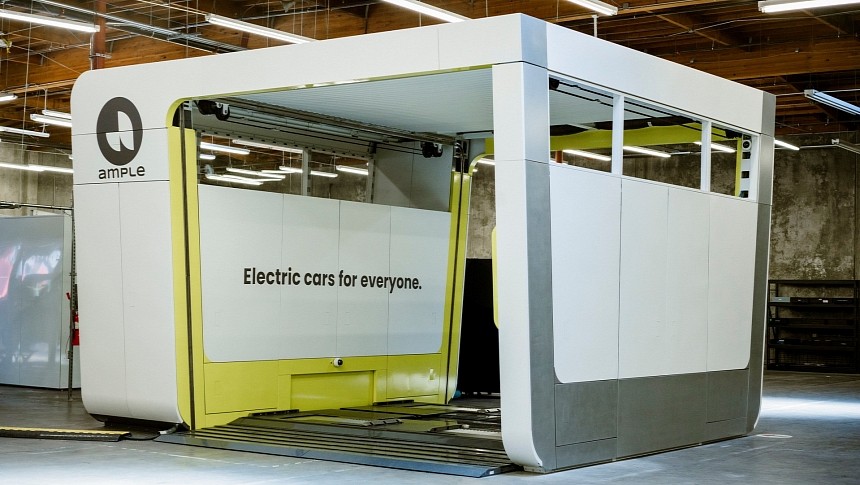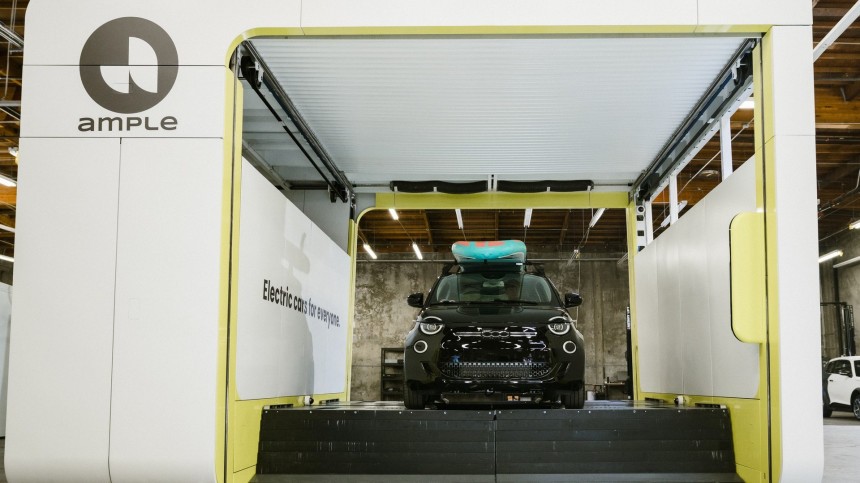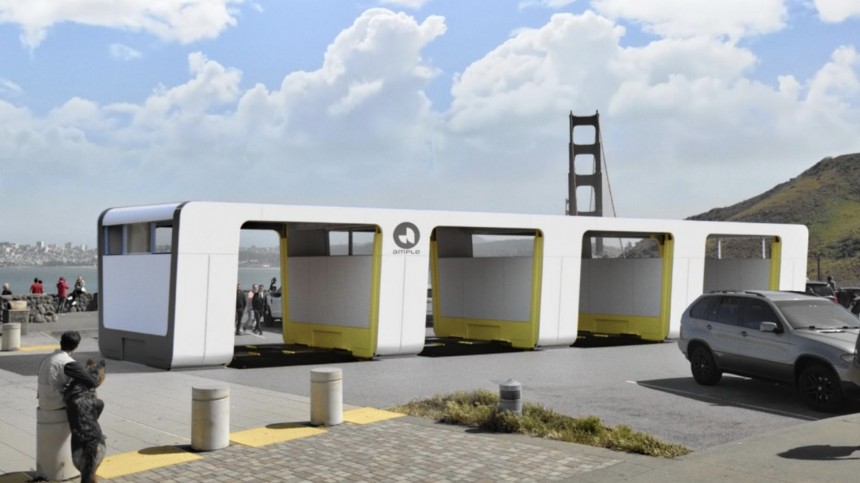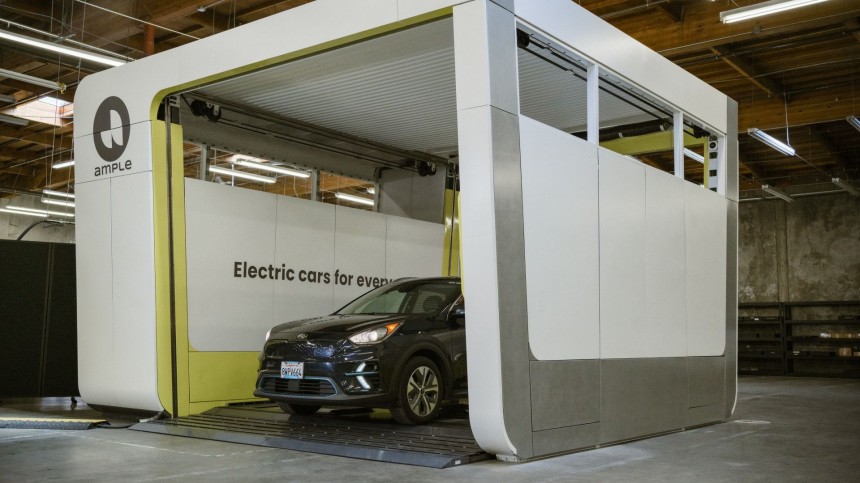Ample recently announced it made a partnership with Fisker for the Ocean to be compatible with its battery module swapping system. What it did not state at the time was that the electric SUV would already benefit from a second-generation swapping station that cut the wait time for the process to complete in half. Instead of the current ten minutes it takes to replace all battery modules, the new station demands only five.
That's pretty handy for a company that proposes creating a universal battery-swapping format. Nowadays, we only have individual efforts in that direction. The closest company to offer a similar solution is CATL, with its Choco-SEBs. All of them have quite a challenge ahead. As Ample puts it, "the EV experience has asked too much of drivers with serious friction points and compromises that will not only hinder but be a deterrent to mass adoption."
The company is talking about charging times. In its work with fleets, it put numbers on something that is quite obvious for anyone familiar with commercial vehicles: "drivers could spend upwards of 10-12 hours, or 25% of a work week, at a charging station." For cars that have to offer the best cost per mile possible, batteries are only a solution if they spend as much time charging as you do filling up a fuel tank. With the current battery tech, that's impossible. Even solid-state cells will not solve that. They may only reduce waiting times, not make them comparable to refueling.
As impressive as five minutes sounds, it just evens the game when compared to other battery-swapping solutions, such as the ones offered by NIO and CATL. To be honest, NIO stated its Power Swap 3.0 stations could do the job in three minutes, so Ample allegedly still has some catching up to do. I say allegedly because that is not a fair comparison. While NIO replaces a single, large component, Ample swaps several modules the size of a shoe box. Doing that in five minutes seems quite fast.
The swapping time probably varies depending on the number of modules that have to be replaced. A compact car can have around 10, while a midsize vehicle may hold 16 to 20 modules. It is only natural to expect a car with twice as many battery modules to take twice as much time to swap them. Sadly, Ample did not elaborate on that. It just shared how much better the second generation of its swap stations is.
According to the company, they take much less time to assemble: three days instead of weeks with the previous station. Ample delivers the stations "in a few pre-built sections," and they "are put together on-site, further simplifying the installation." They can also "be easily stacked so multiple vehicles can swap simultaneously at the same location." Another plus is the "elevated user experience," which the video only shows when the car is already up. It would be interesting to check how long the platform takes to rise up. All Ample said was that it is "safer and more streamlined than ever before." OK…
Ample is already working with Uber and Sally in the Bay Area in California. It described how seamless the battery module swapping is by reporting how an Uber driver did it after driving her car for 120 miles on May 17. She approached the swap station, which recognized her car and opened the door automatically for it. The drive-through design allowed her to enter the station on one side with depleted battery modules and leave it on the other side with fully charged components in only five minutes.
Since bold goals are never too much for startups, Ample said it wants to help put 1 billion electric cars on the streets by making them affordable to everyone. With the swappable battery modules, that gets much easier. Ample's modules will probably be offered in a battery-as-a-service (BaaS) system. That will allow car owners to only worry about motors and the vehicle structure, not about a component that may cost as much as the entire vehicle, as is the case with current battery packs.
With swappable battery modules, drivers can choose to use only part of the vehicle's total capacity. In a compact car, 4 modules instead of 10, just to cover their daily driving needs. When they need to make a road trip, they can place all ten modules in the vehicle and swap them in five minutes in an Ample swap station. Convenience is pretty understated when it comes to EV adoption. Yet, as Ample said, it will likely dictate the future of the BEV shift and put the brakes on it if it is not addressed in the best way possible. Apart from NIO, no car company seems to have understood that so far.
The company is talking about charging times. In its work with fleets, it put numbers on something that is quite obvious for anyone familiar with commercial vehicles: "drivers could spend upwards of 10-12 hours, or 25% of a work week, at a charging station." For cars that have to offer the best cost per mile possible, batteries are only a solution if they spend as much time charging as you do filling up a fuel tank. With the current battery tech, that's impossible. Even solid-state cells will not solve that. They may only reduce waiting times, not make them comparable to refueling.
The swapping time probably varies depending on the number of modules that have to be replaced. A compact car can have around 10, while a midsize vehicle may hold 16 to 20 modules. It is only natural to expect a car with twice as many battery modules to take twice as much time to swap them. Sadly, Ample did not elaborate on that. It just shared how much better the second generation of its swap stations is.
Ample is already working with Uber and Sally in the Bay Area in California. It described how seamless the battery module swapping is by reporting how an Uber driver did it after driving her car for 120 miles on May 17. She approached the swap station, which recognized her car and opened the door automatically for it. The drive-through design allowed her to enter the station on one side with depleted battery modules and leave it on the other side with fully charged components in only five minutes.
With swappable battery modules, drivers can choose to use only part of the vehicle's total capacity. In a compact car, 4 modules instead of 10, just to cover their daily driving needs. When they need to make a road trip, they can place all ten modules in the vehicle and swap them in five minutes in an Ample swap station. Convenience is pretty understated when it comes to EV adoption. Yet, as Ample said, it will likely dictate the future of the BEV shift and put the brakes on it if it is not addressed in the best way possible. Apart from NIO, no car company seems to have understood that so far.




















